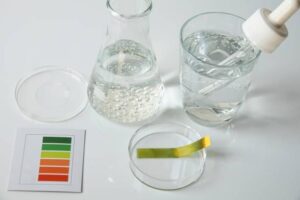
Ever notice blue-green stains on your bathroom fixtures or a metallic taste when you drink? These can indicate low pH levels in your water. Understanding pH levels and their impact is crucial for maintaining your plumbing and ensuring the safety of your drinking supply. Let’s explore what pH means, the causes and effects of low pH in water, and how to treat it.
Understanding the pH Scale and Its Impact
Understanding pH levels, with the help of a pH tester for water or other tools used by your water treatment company, is crucial for optimizing the performance of plumbing systems. Here’s what you need to know:
- The full scale is 0 through 14.
- The number 7 means neutral.
- Any number below 7 means the water is acidic.
- Any number above 7 means the water is alkaline.
A critical difference between a regular thermometer and the pH scale is the scale itself. For instance, a pH of 6 indicates water is ten times more acidic than neutral. On the other hand, a pH two numbers below 7 (pH of 5) means the water is one hundred times more acidic than neutral.
What Causes Low pH Levels?
Low pH levels in water can stem from natural processes and human activities, underscoring the importance of regular water testing to identify potential issues. Here are the primary causes:
- Natural Causes: Natural processes like the decomposition of organic matter and volcanic activity can lower pH. Rainwater, which is slightly acidic due to carbon dioxide, also contributes.
- Man-Made Causes: Industrial emissions, agricultural runoff, and acid rain from burning fossil fuels can significantly decrease pH levels. Pollutants from factories and wastewater discharge further exacerbate the acidity.
What Are the Common Signs of Low pH?
Low pH in water can lead to various noticeable issues around your home. Common signs include:
- Blue or green stains in bathroom fixtures
- Blonde hair turning a greenish color
- Pinhole leaks in your pipes
- Metallic-tasting water
- Corrosion of plumbing fixtures
- Increased wear and tear on appliances
- Cloudy or discolored water
How Do You Treat Low pH Levels?
A neutralizer tank efficiently treats household water by processing it through a container loaded with crushed limestone. This substance slowly dissolves, acting like a large-scale antacid and balancing your well water’s pH. Your water treatment company should annually service your neutralizer, adding calcite as needed. Here’s a table with treatments for water with low and high pH levels:
Symptoms Treatment Low pH (Below 6.5) – Corrosion
– Blue-green staining
– Pinhole leaks in plumbing
– Sour and metallic tasteAcid Neutralizer, Chemical Feed Pump High pH (Above 8.5) – Bitter taste
– Slippery feel to water
– White depositsWhole House Reverse Osmosis
Ensure Safe Drinking Water Today
Recognizing the signs, causes, and treatment options for low-pH water helps safeguard your home and health. If you suspect your water may have low pH levels or require assistance with water testing and treatment solutions, contact H2O Equipment Co., Inc. Take the first step towards safer water today!
